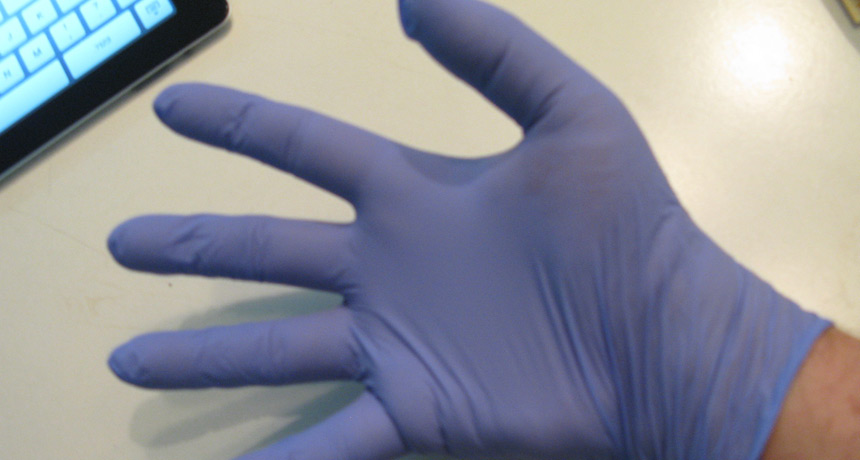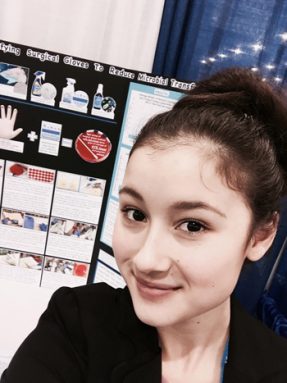Teen makes sure bacteria stay hands-off
She finds a way to keep germs from tainting doctors’ gloves

Gloves like these are used during surgery, to make sure patients aren’t exposed to dangerous germs. A teen studied how to keep them bug-free.
miheco/Flickr (CC-BY-SA-2.0)
PHOENIX, Ariz. — Bacteria can spread even in the cleanest places. Surgeons wash their hands and don gloves before they work, but any bacteria they pick up after that can spread to their patients. Now, Tatiana Ortiz, 15, has shown that adding the right coating can keep bacteria from sticking to a surgeon’s gloves. Her research could one day help prevent some hospital infections.
And by doing this research to help others, Tatiana conquered her own fear of germs.
The teen — who just finished her freshman year at Flour Bluff High School in Corpus Christi, Texas — presented her results in May at the Intel International Science and Engineering Fair. Created by Society for Science & the Public and sponsored by Intel, the annual competition brings together students from around the world to show off their science projects. This year, more than 1,700 students from 75 countries presented their research. (The Society also publishes Science News for Students and this blog.)

Her asthma made her truly fear germs. “I used to think they were all just really bad,” she says. To fight her fears, her parents encouraged her to study bacteria for her science fair projects. And she did, starting in the fourth grade.
The teen decided to study how to prevent patients from getting infections in the hospital. Surgeons wash their hands carefully and put on gloves before surgery, Tatiana explains. But bacteria they get on their hands during surgery can still spread to the patient. Perhaps, she thought, different products on the gloves could help keep bacteria at bay.
Working in a local hospital’s lab with a microbiologist — someone who studies organisms too small to see with your eyes alone — the teen grew groups bacteria. She got these E. coli from a surgical bed handle, something that doctors or nurses might touch often during surgery.
Tatiana then got 32 surgical gloves, which she divided into four groups. Each group got a different treatment. She coated one set with Sharklet-film. This is a film that sticks like tape to a surface. It then prevents bacteria from attaching. She treated another eight with Sani-Shield. This spray also stops bacteria from sticking. She used a germ-killing cleaning product on eight more. She applied colloidal silver, tiny silver particles in liquid, to the last eight gloves. Silver is known for its germ-killing properties.
The teen carefully coated two fingers of each glove in the test product. She left the rest untreated as a control. After the treatments had dried, she exposed all of her gloves to ultraviolet light, which killed any microbes that might still be on the gloves. Then she swiped the fingers of her gloves on rulers coated in her E. coli samples. Afterward, she placed the fingertips of each glove on clean Petri dishes — round dishes used for growing bacteria.
Over the next 24 hours she watched the dishes to see if any bacteria grew. If they did, Tatiana would know that they had come from her contaminated gloves. If the plates could get her “infections,” she reasoned, patients could too.
The most effective treatments were the Sharklet-film and the Sani-Shield spray. They reduced the number of bacteria carried to the plates by 44 percent. The germ killers were less effective. They may simply need a longer contact time with the germs, Tatiana suspects. As such, she now says, “I don’t think it would be effective on gloves in operating rooms because surgeons don’t have the time to stand back and wait for their gloves to kill off the microorganisms.”
The teen hopes that adding a coating to the gloves to prevent bacteria from sticking will decrease infections in hospitals. First, she needs to make the gloves and test them — her next research goal. But as she studied bacteria, Tatiana found she shed her fear of germs. Now when it comes to bacteria, she says, “I can defeat the enemy!”
Follow Eureka! Lab on Twitter
Power Words
(for more about Power Words, click here)
antimicrobial A substance used to kill or inhibit the growth of microbes. This includes naturally derived chemicals, such as many antibiotic medicines. It also includes synthetic chemical products, such as triclosan and triclocarban. Manufacturers have added some antimicrobials — especially triclosan — to a range of sponges, soaps and other household products to deter the growth of germs.
asthma A disease affecting the body’s airways, which are the tubes through which animals breathe. Asthma obstructs these airways through swelling, the production of too much mucus or a tightening of the tubes. As a result, the body can expand to breathe in air, but loses the ability to exhale appropriately. The most common cause of asthma is an allergy. It is a leading cause of hospitalization and the top chronic disease responsible for kids missing school.
bacterium (plural bacteria) A single-celled organism. These dwell nearly everywhere on Earth, from the bottom of the sea to inside animals.
colloid A material in which tiny insoluble particles are spread throughout a larger volume of another substance. Colloids take many forms. Smoky air is a colloid. So is fog. Milk is a colloid, with tiny globs of butterfat suspended throughout the liquid. Whipped cream is a colloid too. Colloids typically don’t separate into their individual components over time.
culture (in biology) The community of cells or tissue that is intentionally grown outside the body (or the wilds) for research purposes, usually in a laboratory. (in social science) The sum total of typical behaviors and social practices of a related group of people (such as a tribe or nation). Their culture includes their beliefs, values, and the symbols that they accept and or use. It’s passed on from generation to generation through learning. Once thought to be exclusive to humans, scientists have recognized signs of culture in several other animal species, such as dolphins and primates.
E. coli (short for Escherichia coli) A bacterium that researchers often use to study genetics. Some types of this microbe cause disease, but many other forms of it do not.
microorganism A living thing that is too small to see with the unaided eye, including bacteria, some fungi and many other organisms such as amoebas. Most consist of a single cell.
microbiology The study of microorganisms, principally bacteria, fungi and viruses. Scientists who study microbes and the infections they can cause or ways that they can interact with their environment are known as microbiologists.
pathogen An organism that causes disease.
Petri dish A shallow, circular dish used to grow bacteria or other microorganisms.
ultraviolet A portion of the light spectrum that is close to violet but invisible to the human eye.